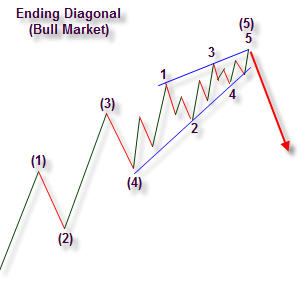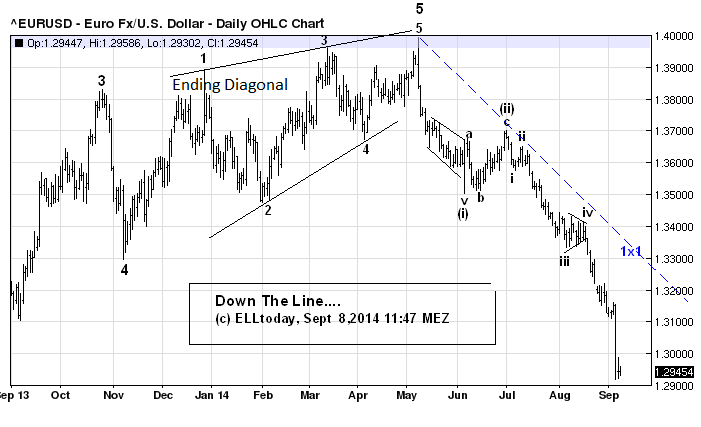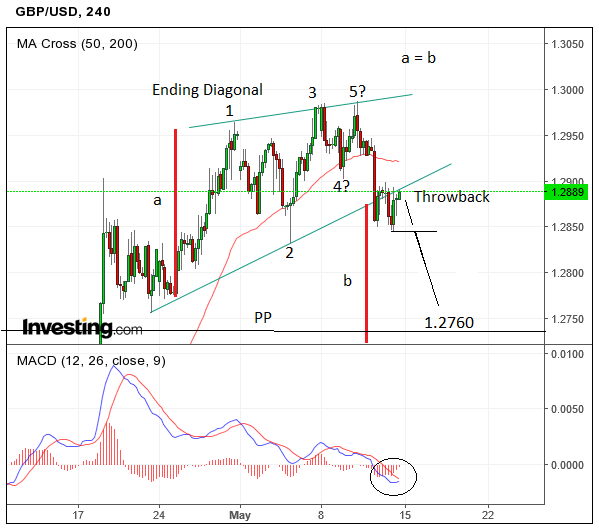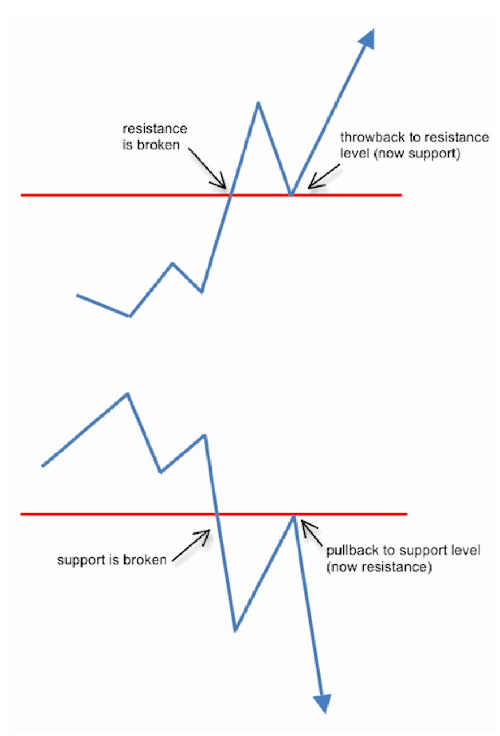Pound to US Dollar Poised to Sell Off Over Next Five Days

GBP/USD rose to within a hair's breadth of the psychologically significant 1.3000 level before rolling over last week and given price action so far, this may be the precursor to a deeper sell off in the coming week.
The pair has formed a topping pattern clearly visible on the four-hour chart, which suggests a strong possibility of further downside.
The pattern is probably what is known amongst technicians as an ending diagonal.

These occur at the end of uptrends and often signal an imminent and strong sell-off in the pair and a reversal of the trend on a higher timeframe.
Below is an idealized image of an ending diagonal and a ‘real’ ending diagonal on EUR/USD as well as the sell-off which followed.

These images look very similar to the ending diagonal which appears to be forming on GBP/USD.
The pattern on GBP/USD shows a truncated or incomplete wave 4 – and therefore is not ideal – however some license is allowed in identification.

The exchange rate has already broken below the lower borderline of the pattern before recovering back up to it.
This is probably what is known as a ‘throwback’, which is the move back to a trendline or pattern border immediately after a breakout has occurred.
These moves almost always result in a resumption direction of the breakout after the exchange rate has said its ‘final goodbye’ or ‘air kiss goodbye’ as it is often referred to by traders, to the trend or borderline.
These are optimum entry points for traders seeking the alchemy of low risk/high reward.

The breakdown and throwback suggests a continuation lower in the week ahead.
The MACD is also very bearishly aligned and now below the zeroline which indicates a change of trend in the traditional interpretation of the indicator, as expressed by its originator Gerald Appel.
We have taken the height of the pattern at its widest point (a) to calculate the potential downside (b), in a method similar to forecasting the extent of a triangle’s breakout.
This appears to forecast a target at around 1.2760, where support kicks in from the monthly pivot.
For confirmation of more downside, however, we would first want to see a break below the 1.2845 lows.
Data for the Dollar
It is a relatively quiet week ahead on the hard data front for the US Dollar.
Building Permits are the first tier-one release and are scheduled to come out on Tuesday, May 16 at 13.30 (BST).
They are expected to show a rise to 1.27m in April.
Housing data has generally been strong lately, suggesting a more upside.
Housing Starts, out at the same time, are forecast to show a rise of 1.26m from a previous result of 1.215m.
The next big release is the Philadelphia Fed Manufacturing Index, out on Thursday at 13.30 which is expected to show a decline to 19.8 from 22.00 previously.
Other data of note is New York Manufacturing, out at 13.30 on Monday and Net flows of financial investments (Net TIC flows) at 21.00, which is forecast to show a rising surplus of inflows into USD.
The Dollar is at risk of downside as expectations of 2 or even 3 hikes in 2017 have started to shift from the reality of slightly below expectations data releases.
“There’s a serious misalignment between U.S. data, market expectations and Fed speak. Friday’s U.S. economic reports raise questions about the possibility of a rate hike in June,” said Kathy Lien in her week ahead report.
Data for the Pound
Retails Sales, on Thursday, May 18 at 9.30 (BST) will probably be the most significant release in the week ahead as it covers the UK economy’s current weak spot.
Consumer spending has slowed in the first quarter as the weak pound has put pushed up the price of many imports leading shoppers to limit the size of their baskets.
This slowdown in the high street is a major concern as if it continues it will depress economic growth significantly given that it accounts for the largest proportion of GDP.
Slower growth will lessen even further the likelihood of the Bank of England (BOE) bringing forward the time when they will raise interest rates.
Given relatively higher interest rates tend to attract more capital flows which increase demand for a currency the pound stands to lose out if the BOE adopt a more dovish tone – which by dovish means more inclined to cut rather than raise interest rates.
Inflation data, on Tuesday, May 16 at 9.30 is the other major release for the currency, as it too could impact on rate setting.
Headline CPI is expected to show a 2.6% rise compared to April last year and 0.4% on a monthly basis.
Unemployment and Earnings data are out on Wednesday at 9.30 and are forecast to show earnings rise by 2.4% compared to March 2016 whilst the unemployment rate is expected to remain unchanged at 4.7%.
The change in those seeking unemployment benefits, meanwhile, is expected to show a rise of 5k in April.
All three of these releases could impact heavily on sterling if they come out very different from expectations, with Kathy Lien of BK asset management, for one, seeing an upside bias to the releases:
“We expect most of these reports to surprise to the upside, particularly the labor data as the PMIs report some of the strongest conditions in the labor market this year,” said Lien.





